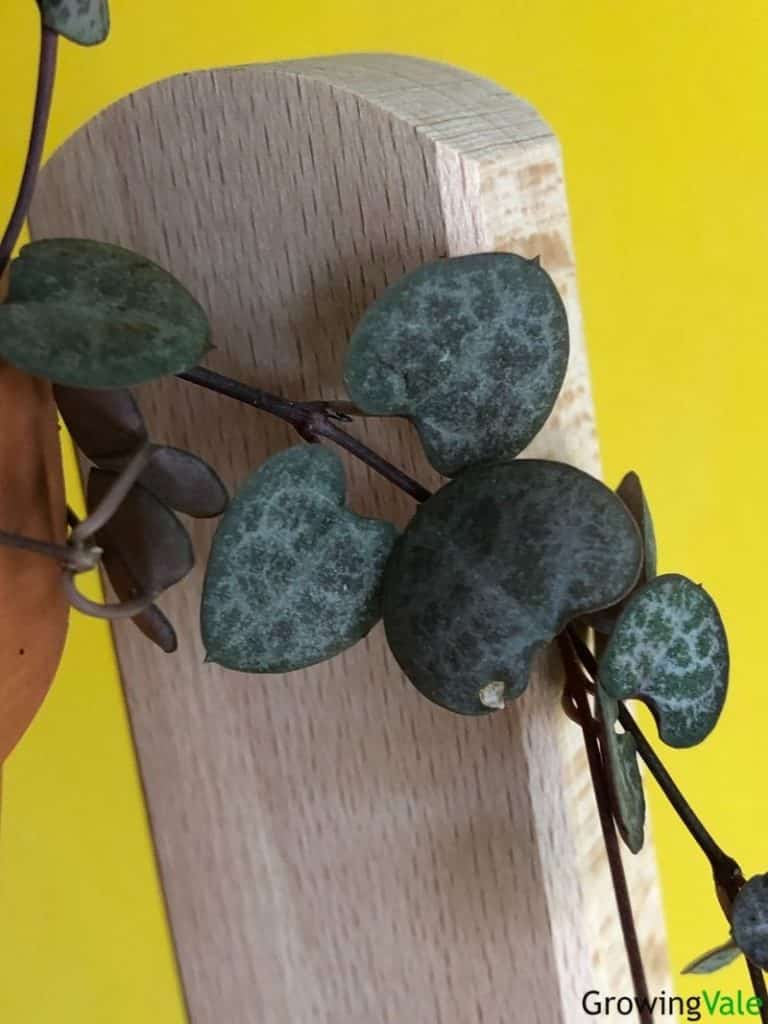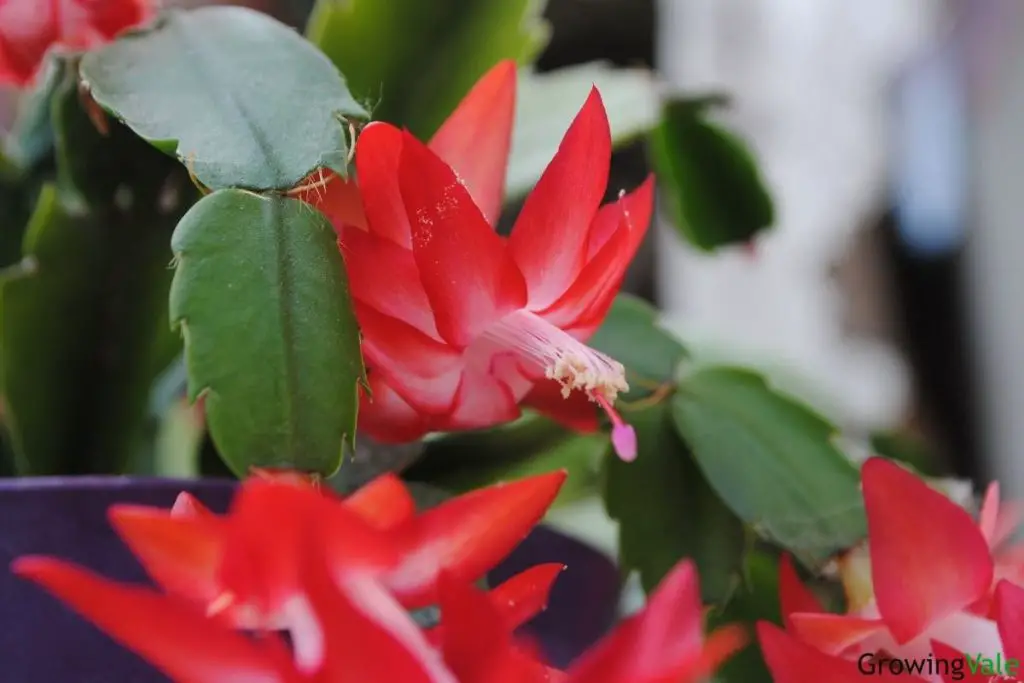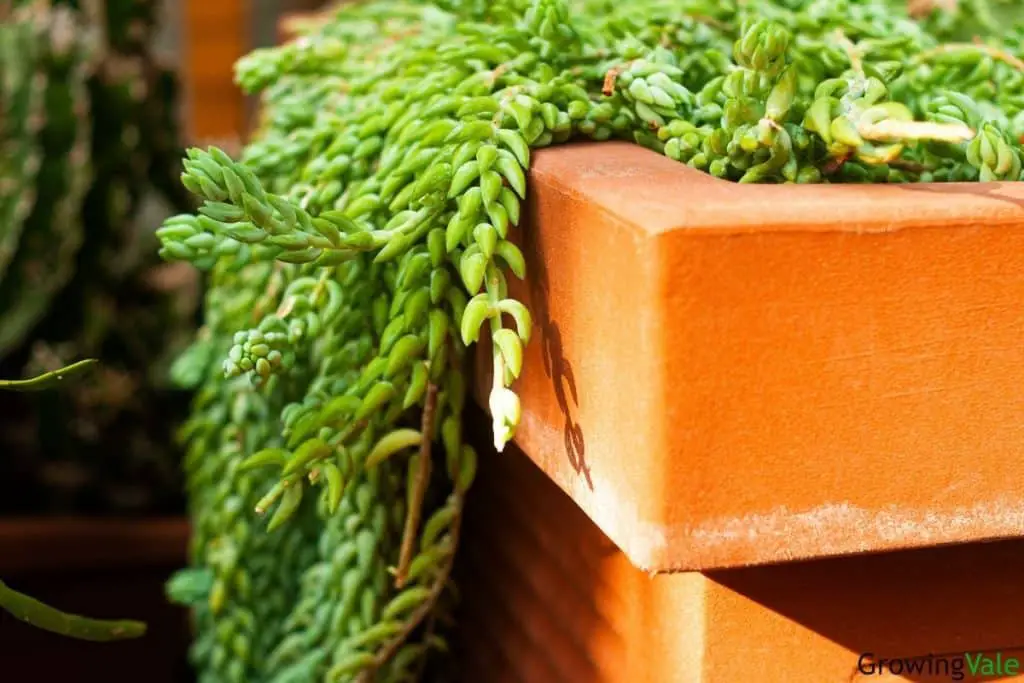There are numerous succulent species that are ideal for growing in hanging planters or baskets. Many of these amazing hanging succulent plants produce long trailing stems that cascade down over the edges of the pot to create a truly magnificent display.
These hanging plants are ideal for hanging indoors near a bright window or from beams on your patio or veranda to create a tranquil indoor or outdoor space.
Here are the 33 most popular hanging and trailing succulents for your hanging garden.
1 Aloiampelos ciliaris (Climbing aloe)
This is a very hardy hanging succulent that is also fast growing. It produces long, thin stems that shoot upwards and eventually trail down. The dark green leaves on this plant have soft, white, and hair-like teeth along their margins. Like most aloe plants, the leaves have a tendency to curve downward on the ends.
This species of aloe will produce flowers almost all year. However, its main flowering season is spring. The flowers are large and bright orange-red with light green tips.
2 Callisia repens (Turtle vine)
This is a vining succulent that would lend itself perfectly to being grown in a hanging pot with well draining soil. It has a dense growth pattern with multiple stems. These stems sport dark green leaves that are purple underneath. The leaves grow in opposite pairs along the stems.
The flowers appear from late spring and are quite small and white.
3 Ceropegia haygarthii (Lantern flower)
This is a stunning trailing plant that experiences vigorous growth with lovely, thick green trailing stems that have small leaves. These leaves are egg-shaped and bright green.
The flowers are quite spectacular and very unusual in appearance. They’re tubular with a cream tube that is flecked with purple. The tube widens at the tip and has a bright green inner coloring. The seed pods grow on a short stem from the tip of the tube and are dark red in color.
4 Ceropegia linearis (String of needles)
This lovely hanging plant produces long, slender stems that grow from a tuber. The light green leaves are quite slender and lack the bright patterns of the sub-species woodii.
The flowers are delicate tubular blooms that can be up to 1.2 inches long. The plant has either white or magenta colored flowers. These will appear in late summer through to early fall, lasting up to six weeks.
5 Ceropegia linearis subsp. woodii (String of hearts or Rosary vine)

This attractive succulent has heart-shaped leaves that are pale green and sometimes red. They are heavily patterned with gray-green or dark-crimson splotches and margins. Each stem can grow to a length of 13 feet. If grown in poor light conditions, the leaves will be pale green but these will turn dark green when the plant is exposed to plenty of indirect light.
The flowers appear in late summer to fall and these can last up to six weeks. These flowers are long and tubular and usually a pale pink color.
6 Crassula capitella (Shark’s tooth or Red pagoda)
This attractive Crassula succulent has fleshy leaves that are propeller-shaped and arranged in whorls around each stem. Like most succulents, it’s drought tolerant. The leaves are lime green, to begin with, and turn to bright red as they mature.
The flowers on this succulent are white or cream and can sometimes be tinged with pink. They appear in clusters.
7 Crassula pellucida subsp. variegata (Calico kitten)
This is a colorful succulent with branched stems that have small heart-shaped leaves arranged around them. The leaves are variegated with a dark green stripe in the center and are often edged in red. The undersides of the leaves are also red.
Flowers appear in late spring through to early summer. They are white in color.
8 Crassula perforata (String of buttons)
This sprawling succulent has thick, fleshy triangular leaves that are gray-green with red margins. These are arranged as opposites on the fleshy stems. Over time, the stems become woodier. When you look closely at the leaves, they have a slightly speckled appearance.
Flowers appear in spring and are white to pale yellow. They’re quite small and star-shaped
9 Crassula sarmentosa (Variegated trailing jade plant)
This lovely trailing succulent has slender stems and fleshy leaves that are arranged in whorls around each stem. The stems are red in color and can be up to 3.3 feet long. When grown in shady conditions, the leaves are dark green but when exposed to bright indirect sunlight, they turn a bright green and eventually, salmony pink with dark red margins.
The flowers appear as densely branched heads and are small and star-shaped. They are usually white to pale pink.
10 Crassula volkensii
This very attractive Crassula has trailing stems with lovely fleshy green leaves that are spotted with dark red. The white star-shaped flowers can appear in profusion all over the plant at the end of the stems in early spring.
11 Curio citriformis (String of tears)
This lovely string succulent was formerly known as Senecio citriformis. Like the other ‘string’ succulents, it has long trailing stems with teardrop-shaped leaves. These leaves are faintly striped and have a pointed end. The leaves can also be covered with a waxy coating.
The flowers appear from late summer to winter and are creamy-yellow in color.
12 Dischidia nummularia (String of nickels)
Although this succulent is an epiphyte, it will grow happily if you plant it in a hanging basket using an orchid mix. It must be allowed to dry out before giving it more water. Because it likes high humidity, you should actually mist this plant if the air is particularly dry.
The plant produces multiple slender stems with small button-shaped leaves that are greenish-yellow. Flowers appear in spring and are white or sometimes pale yellow.
13 Dorotheanthus bellidiformis (Ice daisy or Livingstone daisy)
You’ll also find this plant labeled as Cleretum bellidiforme. It’s an annual succulent with the most striking bright pink daisy-like flowers. The petals are white at the base and bright pink on the top half. The centers of the flowers are dark red. Other flower colors are also available including yellow, white, cream, orange, and crimson.
The branches spread readily and have leaves that are green and sometimes, tinged with maroon. Even though this plant is grown as an annual, if you live in a region that has mild winters, you might be able to keep it alive over this period.
14 Graptopetalum paraguayense (Ghost plant)

This attractive ghost plant succulent deserves pride of place in your home with its almost gray leaves that grow on the ends of branched stems in a gorgeous rosette pattern. If the plant is exposed to hot and dry conditions, the leaves will change color and become almost pinkish-yellow.
When the plant flowers in spring, it produces small, star-shaped blooms that are white in color and have small red spots.
15 Hatiora salicornioides (Dancing bones)
This has to be one of the more unusual succulents on our list. It’s actually a spineless cactus but worth including here. It has slender stems that are branched and arching. Each stem can grow up to 2 feet long and segmented into 1.2 inch sections. Each section or segment is in the shape of a bottle or club.
The flowers are quite striking too. These appear on the ends of the stems and are bell-shaped and orange-yellow in color.
16 Hylotelephium tatarinowii
This attractive succulent was formerly known as Sedum tatarinowii. It’s a lovely plant that has thick tuberous roots and a multitude of simple stems with gray-green leaves. These leaves have toothed margins and often have a pinkish tinge around the edges. It’s important not to overwater this plant if you want to avoid root rot.
The flowers appear as terminal clusters on the ends of the stems in summer. They are white and star-shaped with red anthers.
17 Hoya carnosa (Wax plant)
This popular succulent plant has lovely dark green leaves that have a shiny, waxy appearance. The plant trails beautifully down any pot that you want to grow it in and can be grown in partial shade.
In spring, the plant will start to bloom with the most amazing sweetly scented flowers. These flowers grow in a cluster on the ends of a stem called a peduncle. You’ll usually find that the tiny flowers will mature gradually as the cluster becomes more and more rounded and filled with flowers. The flowers themselves are normally light pink with dark pink centers.
If you look closely, you’ll see that the flowers are covered with tiny hairs. These give the blooms a kind of fuzzy sheen.
18 Hoya compacta (Hindu rope)
This interesting Hoya features curly leaves that grow closely on long trailing stems. They’re waxy on top in a dark green color.
The flowers appear on peduncles and are star-shaped. They mature successively and will eventually form an almost round ball of individual blooms on each peduncle. The flowers themselves are normally pale pink with a dark red center.
19 Hoya pachyclada (Wax plant)
This is another stunning Hoya with beautiful large cream flowers. It’s a slower grower than other Hoya species but still worth considering. Like most drought tolerant succulents, it has very thick and fleshy leaves that are bright green with red margins.
The flowers are absolutely stunning. They’re white and glossy and form a perfect ball of small blooms. The flowers are also scented and appear in spring and summer.
20 Othonna capensis (Little pickles)
This spreading succulent is just made for hanging pots. It features long, trailing stems that bear pickle-shaped succulent leaves which are arranged in a spiral around the stem. They are generally blue-green in color but can turn shades of lavender and red when exposed to bright light indoors or when the plant is under stress.
The flowers are yellow and daisy-like. They usually appear from the middle of spring right through into the fall on long stems that can extend up to 2 inches beyond the foliage.
21 Othonna capensis ‘Ruby Necklace’
This lovely colorful succulent has bean-shaped leaves that can change color from dark green to burgundy and purple. The trailing stems are bright red to purple in color.
The bright yellow daisy-like flowers grow on reddishstems above the foliage. You can expect these to appear all year round.
22 Peperomia prostrata (String of turtles)
This lovely trailing succulent creates a beautiful display when grown in hanging baskets. The long and thick succulent stems will cascade happily over the edges of the pot and will delight you with the dark green to purple leaves. The leaves have an interesting pattern that resembles the pattern found on a turtle’s shell.
In contrast, the narrow flower spikes are quite uninspiring as they poke up through the foliage. They are reddish-brown in color.
23 Portulacaria afra (Elephant bush)
This interesting succulent is called elephant bush because, in its native habitat, it is actually eaten by elephants. In fact, it’s one of their favorite foods. Naturally, it grows as a small bush but the stems can get quite long, so the plant lends itself perfectly to being grown in a hanging pot.
The stems are brown and woody and they are covered with bright green succulent leaves that are tear-shaped. The plant itself looks very similar to a miniature jade plant.
The flowers bloom in dense sprays at the end of short branchlets in late spring to early summer. They’re small and star-shaped and are colored pink to mauve.
24 Schlumbergera bridgesii (Christmas cactus)

The Christmas cactus plant is a popular succulent that is grown by people right around the world. It has long, trailing foliage with leaf segments that are flat and green in color.
The most stunning aspect of this succulent are the bright and colorful fuchsia-like flowers that appear in winter. Hence, the popularity of this plant as not too many other succulents bloom during this time. The flowers are long-lived and are usually red or dark pink in color.
25 Sedum burrito (Burro’s tail or Baby donkey tail)
The donkey tail is another very popular succulent. The long, trailing stems are densely packed with fleshy gray-green leaves that are quite rounded. These leaves are sometimes covered with a powdery bloom giving them a fuzzy appearance.
The flowers appear in spring in terminal clusters. They are small and star-shaped. They’re pink in color and have darker pink lines on their petals.

26 Sedum morganianum (Donkey’s tail or Lamb’s tail)
When you grow this succulent in a hanging pot, you’ll be surprised at the large number of pendant stems that trail down over the edges of the pot. These stems are densely packed with fleshy green leaves that look a little like short, fat beans or tiny green bananas.
You do have to be careful to not handle this plant too often as the leaves are prone to dropping off with even the slightest touch. The flowers appear on long stems and form a cluster in spring. They are purplish-pink to reddish-purple.
27 Sedum x rubrotinctum (Jelly bean plant)
This stunning succulent will delight you with its jelly bean-shaped leaves that can be dark green or bright red all on the same plant. These leaves grow on long trailing stems. The leaves are very glossy and bright.
In contrast, the flowers are small, star-shaped, and yellow in color.
28 Sedum sieboldii (October daphne)
You might find this plant referred to as Hylotelephium sieboldii as it appears to have had a name change. No matter the name, it’s a stunning succulent that you will want to add to your collection.
It produces masses of long stems that bear heart-shaped leaves in whorls around the stem. These leaves are a lovely soft blue-gray color with a faint pink margin.
In the fall, you’ll be stunned by the large clusters of bright pink flowers that are star-shaped and that appear on the ends of the stems. Interestingly, the foliage of this plant is likely to die down in winter but will grow back again in spring.
29 Senecio herreianus (String of beads or String of tears)
You might find this plant is now called Curio herreanus due to a recent name change. It’s also commonly called ‘String of watermelons’. It has long trailing stems with egg-shaped leaves that are pale green with darker green stripes. If you look closely at a leaf, you’ll see a small translucent window. If the plant is grown in full sun, the leaves will turn a brilliant purple in color.
The white flowers are small and brush-like. They can appear in spring right through until fall.
30 Senecio jacobsenii (Trailing jade)
This lovely trailing succulent plant has long stems that are thick and fleshy. The leaves are egg-shaped and jade green. These can get a lovely purple blush in the winter. They also have an interesting habit of standing upright on the trailing stems.
The flowers appear in the fall and go through until winter. They’re bright orange and composite.
31 Senecio x peregrinus (String of dolphins)

This is one of the most delightful succulents on our list. It can also be called Senecio ‘Hippogriff’ or Curio x peregrinus. It has the cutest green leaves that resemble leaping dolphins. They grow on soft succulent stems that just love to trail down over the edges of a hanging planter.
The flowers tend to appear in the fall. They are small and white and form little puffballs that are tightly compacted.
32 Senecio radicans (String of bananas)
‘String of bananas’ is another popular “string” succulent and can sometimes be labeled as Curio radicans. It’s quite similar to ‘String of dolphins’, except that the fleshy green leaves are shaped like miniature green bananas. These leaves also have translucent windows on either side.
The flowers that appear in late winter to early spring have a lovely cinnamon fragrance. They’re quite small and white in color.
33 Senecio rowleyanus (String of pearls)
This is another one of the most popular ‘string’ succulents. You might also find it named as Curio rowleyanus. It has long trailing stems with small pea-shaped leaves that look just like green pearls. As the stems grow and trail over the edge of the hanging container or basket, they form quite a spectacular display, almost like a green waterfall. The leaves on this succulent also have a translucent stripe.
The flowers grow in clusters and appear in summer. They also have a lovely cinnamon scent. They’re white in color with long red stamens and yellow anthers.
We hope this list of hanging succulents gives you a good look at what’s possible. Don’t forget to check our list of string succulents and other cool types of cactus including rat tail cactus for more ideas.

